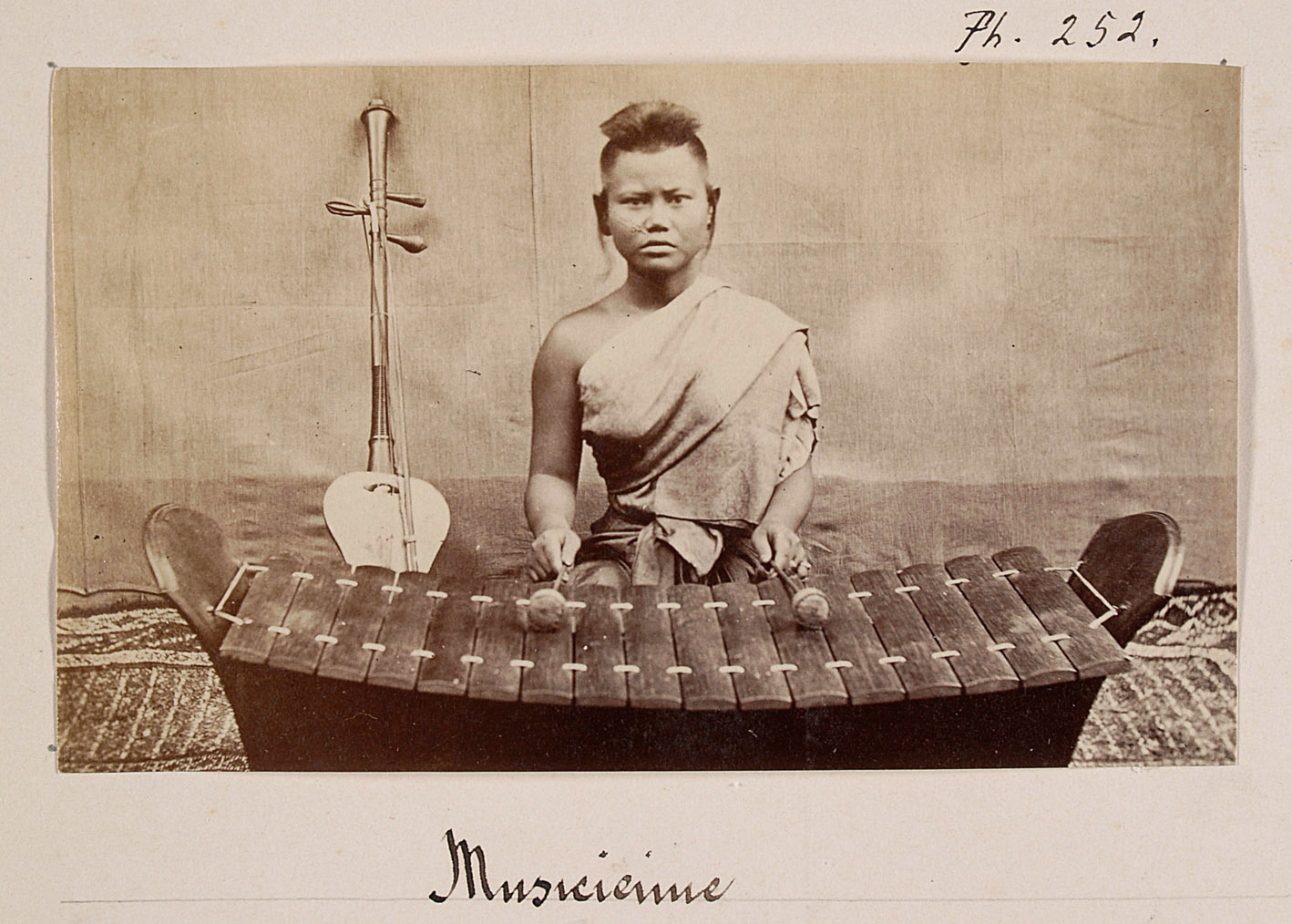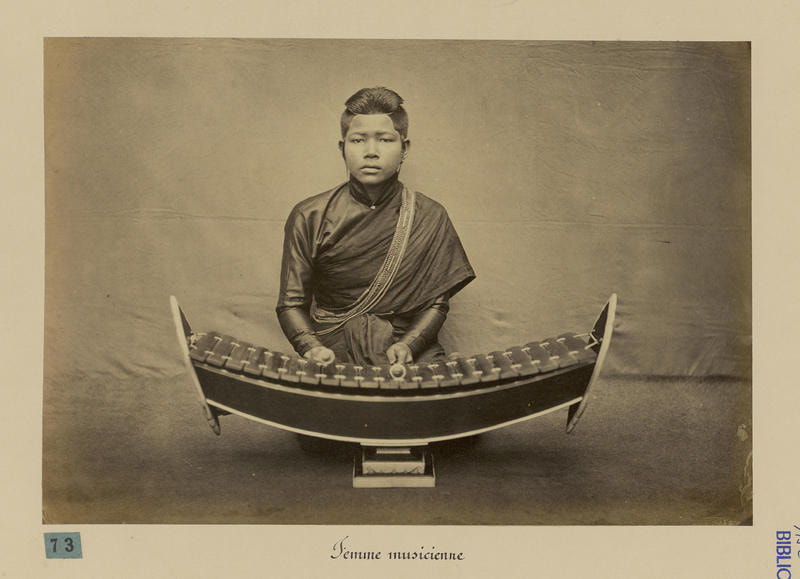|
Roneat Thung
The ''roneat thung'' or ''roneat thum'' ( km, រនាតធុង) is a low-pitched xylophone used in the Khmer classical music of Cambodia. It is built in the shape of a curved, rectangular shaped boat. This instrument plays an important part in the ''Pinpeat'' ensemble. The ''roneat Thung'' is placed on the left of the ''roneat ek'', a higher-pitched xylophone. The ''Roneat Thung'' is analogous to the ''ranat thum'' of Thai. Etymology ''Roneat'' means xylophone where ''thung'' literally mean oodencontainer in Khmer. This may derived from the shape of this type of xylophone which shaped like a rectangular wooden container. Terry E. Miller and Sean Williams in their book ''The Garland Handbook of Southeast Asian Music'', Roneat Thung is better called ''Roneat thomm/ thum'' which literally means "large xylophone". This name may designates the fact that roneat thum's resonator and note bars are larger and longer than those of roneat ek. History Roneat Thung, the sister mu ... [...More Info...] [...Related Items...] OR: [Wikipedia] [Google] [Baidu] |
Percussion Instrument
A percussion instrument is a musical instrument that is sounded by being struck or scraped by a beater including attached or enclosed beaters or rattles struck, scraped or rubbed by hand or struck against another similar instrument. Excluding zoomusicological instruments and the human voice, the percussion family is believed to include the oldest musical instruments.''The Oxford Companion to Music'', 10th edition, p.775, In spite of being a very common term to designate instruments, and to relate them to their players, the percussionists, percussion is not a systematic classificatory category of instruments, as described by the scientific field of organology. It is shown below that percussion instruments may belong to the organological classes of ideophone, membranophone, aerophone and cordophone. The percussion section of an orchestra most commonly contains instruments such as the timpani, snare drum, bass drum, tambourine, belonging to the membranophones, and cym ... [...More Info...] [...Related Items...] OR: [Wikipedia] [Google] [Baidu] |
Cambodian Roneat Thung
Cambodian usually refers to: * Something of, from, or related to the country of Cambodia ** Cambodian people (or Khmer people) ** Cambodian language (or Khmer language) ** For citizens and nationals of Cambodia, see Demographics of Cambodia ** For languages spoken in Cambodia, see Languages of Cambodia Cambodian may also refer to: Other * Cambodian architecture * Cambodian cinema Cinema in Cambodia began in the 1950s, and many films were being screened in theaters throughout the country by the 1960s, which are regarded as the "golden age". After a near-disappearance during the Khmer Rouge regime, competition from video an ... * Cambodian culture * Cambodian cuisine * Cambodian literature * Cambodian music * Cambodian name * Cambodian nationalism * Cambodian descendants worldwide: ** Cambodian Americans ** Cambodian Australians ** Cambodian Canadians ** Cambodians in France See also * * List of Cambodians {{disambig Language and nationality disambiguation pages [...More Info...] [...Related Items...] OR: [Wikipedia] [Google] [Baidu] |
Traditional Cambodian Instruments
Traditional Cambodian musical instruments are the musical instruments used in the traditional and classical music of Cambodia. They comprise a wide range of wind, string, and percussion instruments, used by both the Khmer majority as well as the nation's ethnic minorities. File:Shoulder-mounted nipple gong at Angkor Wat.jpg, Soldiers carry drums and a shoulder-mounted nipple gong in relief at Angkor Wat. File:Kse diev at Angkor Wat, North Section, 16th Century.jpg, Kse diev at Angkor Wat, North Section, 16th Century. File:Kongpeat from Angkor Wat.jpg, Khmer gong chimes from Angkor Wat. Woodwind Flute *Khloy ( km, ខ្លុយ) - vertical duct flute made of bamboo, hardwood, or plastic, with buzzing membrane ** Khloy ek - smaller in size ** Khloy thom - larger in size Free-reed * Sneng ( km, ស្នែង) - water buffalo or ox horn with a single free reed * Pey pok ( km, ប៉ីពក) - free-reed pipe While similar to a flute, it uses a single reed to create sound ... [...More Info...] [...Related Items...] OR: [Wikipedia] [Google] [Baidu] |
Roneat Dek
Roneat ( km, រនាត) is the generic Khmer word for referring to several types of xylophones used in traditional Cambodian music; the pinpeat and mohaori. Roneat may refers to several Cambodian xylophone types such as roneat thmor, roneat ek, roneat thung, roneat dek, and roneat thaong. Etymology The word "roneat" is a Khmer word for the bamboo xylophone, which is an ancient musical instrument of Cambodia. According to the Khmer national dictionary, roneat means xylophone and is described as "the percussive musical instrument that has a long body where its bars are made from bamboo or other good quality woods or metal bars striking with a pair of two roneat sticks played in the pinpeat and mohaori orchestras. ''The Garland Handbook of Southest Asian Music'' edited by Terry E. Miller and Sean Williams, argued that the word ''roneat'' is a Khmer generic term that refers to xylophones or metallophones — idiophones, with bars of bamboo, wood, or metal. The word roneat ... [...More Info...] [...Related Items...] OR: [Wikipedia] [Google] [Baidu] |
Nāga
The Nagas (IAST: ''nāga''; Devanāgarī: नाग) are a divine, or semi-divine, race of half-human, half-serpent beings that reside in the netherworld (Patala), and can occasionally take human or part-human form, or are so depicted in art. A female naga is called a Nagi, or a Nagini. According to legend, they are the children of the sage Kashyapa and Kadru. Rituals devoted to these supernatural beings have been taking place throughout South Asia for at least 2,000 years. They are principally depicted in three forms: as entirely human with snakes on the heads and necks, as common serpents, or as half-human, half-snake beings in Hinduism, Buddhism, and Jainism. ''Nagaraja'' is the title given to the king of the nagas. Narratives of these beings hold cultural significance in the mythological traditions of many South Asian and Southeast Asian cultures, and within Hinduism and Buddhism, they are the ancestral origins of the Nagavanshi Kshatriyas. Etymology In Sanskrit, a () ... [...More Info...] [...Related Items...] OR: [Wikipedia] [Google] [Baidu] |
Mohaori
Mohaori ( Khmer: មហោរី) is one of the traditional musical ensembles of Cambodia. This traditional ensemble is known in full name as Vung Phleng Mohaori (វង់ភ្លេងមហោរី), literally means ''Mohaori Musical Ensemble''. It composed of many kinds of musical instruments, but today it is more specifically applied to a small ensemble of wind, stringed, and percussion musical instruments. This musical art is thought to be predated Angkorian period and probably dated back to as early as the 9th century. Mohaori became more popular and further developed in the Post-Angkorian era until the present days. The songs and lyrics of Mohaori music normally depict the beauty and admiration of nature, and the confession of love. The Music played by this Khmer ensemble is gentle and fluid which is suitable for an entertainment in Cambodian social and traditional events. Nowadays, Mohaori is still a popular Khmer traditional music played in various occasions and fes ... [...More Info...] [...Related Items...] OR: [Wikipedia] [Google] [Baidu] |
Music Of Cambodia
The music of Cambodia is derived from a mesh of cultural traditions dating back to the ancient Khmer Empire, India, China and the original indigenous tribes living in the area before the arrival of Indian and Chinese travelers. With the rapid Westernization of popular music, Cambodian music has incorporated elements from music around the world through globalization. Folk and classical music Cambodian Art music is highly influenced by ancient forms as well as Hindu forms. Religious dancing, many of which depict stories and ancient myths, are common in Cambodian culture. Classical Khmer music usually is divided into three parts: ''pin peat, phleng kar,'' and ''mahori,'' all of which are associated with their religious dances. Some dances are accompanied by a pinpeat orchestra, which includes a ching (cymbal), roneat (bamboo xylophone), pai au (flute), sralai (oboe), chapey (bass moon lute or banjo), gong (bronze gong), tro (fiddle), and various kinds of drums. Each movement ... [...More Info...] [...Related Items...] OR: [Wikipedia] [Google] [Baidu] |
Gambang
A gambang, properly called a gambang kayu ('wooden gambang') is a xylophone-like instrument used among people of Indonesia in gamelan and kulintang, with wooden bars as opposed to the metallic ones of the more typical metallophones in a gamelan. A largely obsolete instrument, the gambang gangsa, is a similar instrument made with metal bars. Gambang kayu The bars of the instrument are made of a se wood, generally teak. It also found in ironwood (kayu besi). The bars mounted in a deep wooden case that serves as a resonator. Instruments typically have 17-21 keys that are easily removed, and are kept in place by having a hole through which a nail is placed. Generally a full gamelan has two sets, one gambang pelog and the other one gambang slendro. A pair of long thin mallets (''tabuh''), made of flexible water buffalo horn tipped with felt, are used to play the instrument. Gambangs are generally played in parallel octaves (gembyang). Occasionally, other styles of playing are employed ... [...More Info...] [...Related Items...] OR: [Wikipedia] [Google] [Baidu] |
Myanmar
Myanmar, ; UK pronunciations: US pronunciations incl. . Note: Wikipedia's IPA conventions require indicating /r/ even in British English although only some British English speakers pronounce r at the end of syllables. As John C. Wells, John Wells explains, the English spellings of both Myanmar and Burma assume a non-rhotic variety of English, in which the letter r before a consonant or finally serves merely to indicate a long vowel: [ˈmjænmɑː, ˈbɜːmə]. So the pronunciation of the last syllable of Myanmar as [mɑːr] or of Burma as [bɜːrmə] by some speakers in the UK and most speakers in North America is in fact a spelling pronunciation based on a misunderstanding of non-rhotic spelling conventions. The final ''r'' in ''Myanmar'' was not intended for pronunciation and is there to ensure that the final a is pronounced with the broad a, broad ''ah'' () in "father". If the Burmese name my, မြန်မာ, label=none were spelled "Myanma" in English, this would b ... [...More Info...] [...Related Items...] OR: [Wikipedia] [Google] [Baidu] |
Gamelan
Gamelan () ( jv, ꦒꦩꦼꦭꦤ꧀, su, ᮌᮙᮨᮜᮔ᮪, ban, ᬕᬫᭂᬮᬦ᭄) is the traditional ensemble music of the Javanese, Sundanese, and Balinese peoples of Indonesia, made up predominantly of percussive instruments. The most common instruments used are metallophones played by mallets and a set of hand-played drums called '' kendhang/Kendang'', which register the beat. The kemanak (a banana-shaped idiophone) and gangsa (another metallophone) are commonly used gamelan instruments in Bali. Other instruments include xylophones, bamboo flutes, a bowed instrument called a ''rebab'', a zither-like instrument ''siter'' (in Javanese ensemble) and vocalists named '' sindhen'' (female) or ''gerong'' (male).Sumarsam (1998)''Introduction to Javanese Gamelan'' Middletown. Although the popularity of gamelan has declined since the introduction of pop music, gamelan is still commonly played in many traditional ceremonies and other modern activities in Indonesia, b ... [...More Info...] [...Related Items...] OR: [Wikipedia] [Google] [Baidu] |
Roneat Ek
The ''Roneat Ek'' or Roneat Aek ( km, រនាតឯក; also called ''Roneat Rut'') is a xylophone used in the Khmer classical music of Cambodia. It is built in the shape of a curved, rectangular shaped boat. It has twenty-one thick bamboo or hard wood bars that are suspended from strings attached to the two walls. They are cut into pieces of the same width, but of different lengths and thickness. Originally these instruments were highly decorated with inlay and carvings on the sides of the sound box. Now they are simpler. The Roneat is played in the ''Pinpeat'' ensemble. In that ensemble, sits on the right of the ''Roneat Thung'', a lower-pitched xylophone. The ''roneat ek'' is the analogous equivalent to the Thai xylophone called ''ranat ek'', and the Burmese bamboo xylophone called "pattala". Etymology The word "roneat" is a Khmer word for the bamboo xylophone, which is an ancient musical instrument of Cambodia. According to the Khmer national dictionary, roneat means xylo ... [...More Info...] [...Related Items...] OR: [Wikipedia] [Google] [Baidu] |
Roneat Thung
The ''roneat thung'' or ''roneat thum'' ( km, រនាតធុង) is a low-pitched xylophone used in the Khmer classical music of Cambodia. It is built in the shape of a curved, rectangular shaped boat. This instrument plays an important part in the ''Pinpeat'' ensemble. The ''roneat Thung'' is placed on the left of the ''roneat ek'', a higher-pitched xylophone. The ''Roneat Thung'' is analogous to the ''ranat thum'' of Thai. Etymology ''Roneat'' means xylophone where ''thung'' literally mean oodencontainer in Khmer. This may derived from the shape of this type of xylophone which shaped like a rectangular wooden container. Terry E. Miller and Sean Williams in their book ''The Garland Handbook of Southeast Asian Music'', Roneat Thung is better called ''Roneat thomm/ thum'' which literally means "large xylophone". This name may designates the fact that roneat thum's resonator and note bars are larger and longer than those of roneat ek. History Roneat Thung, the sister mu ... [...More Info...] [...Related Items...] OR: [Wikipedia] [Google] [Baidu] |







